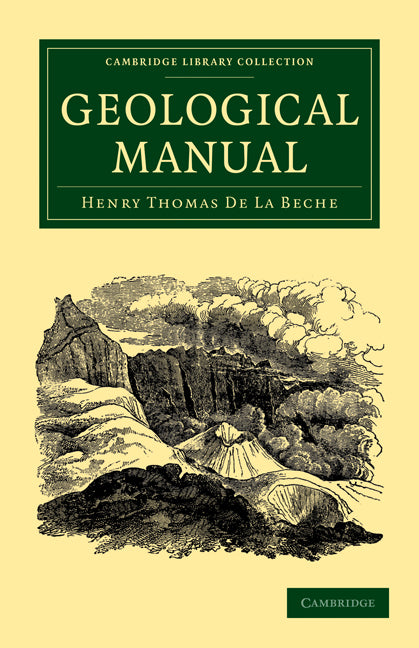Freshly Printed - allow 8 days lead
Couldn't load pickup availability
A Geological Manual
A comprehensive guide to geology, covering topics such as rock classification and fossils, written by a prominent nineteenth-century geologist.
Henry Thomas De La Beche (Author)
9781108072557, Cambridge University Press
Paperback / softback, published 19 May 2011
648 pages
21.6 x 14 x 3.6 cm, 0.81 kg
Henry De la Beche (1796–1855) was a geologist who published widely on various aspects of this science and was elected to the Royal Society in 1823. He was involved with the Ordnance Survey maps of Britain, and became president of the Geological Society in 1847. De la Beche was also instrumental in the 1851 opening of two influential institutions: the Museum of Practical Geology and the School of Mines and of Science Applied to the Arts, which were housed on the same site in London. His Geological Manual, first published in 1831, also had French, German and US editions. In this expanded third edition, published in 1833, the work offers a comprehensive survey of multiple aspects of geology. Topics covered include an overview of the Earth, rivers, glaciers, rock types and fossils in France and England, demonstrating the range and depth of geological knowledge in the early nineteenth century.
Preface
Section I: 1. Figure of the Earth
2. Density of the Earth
3. Superficial distribution of land and water
4. Saltness and specific gravity of the sea
5. Temperature of the Earth
6. Temperature of springs
7. Temperature of the sea and of lakes
8. Temperature of the atmosphere
9. Valleys
10. Changes on the surface of the globe
11. Classification of rocks
Section II: 12. Degradation of land
13. Rivers
14. Glaciers
15. Delivery of detritus into the sea
16. Action of the sea on coasts
17. Shingle beaches
18. Sandy beaches
19. Tides
20. Currents
21. Transporting power of tides
22. Transporting power of currents
23. Active volcanos
24. Extinct volcanos
25. Mineral volcanic products
26. Volcanic dykes, etc.
27. Earthquakes
28. Hurricanes
29. Gaseous exhalations
30. Deposits from springs
31. Naphtha and asphaltum springs
32. Coral reefs and islands
33. Submarine forests
34. Raised beaches and masses of shells
35. Organic remains of the modern group
Section III: 36. Erratic blocks and gravel
37. Ossiferous caverns and osseous breccia
Section IV: 38. Supracretaceous (tertiary) group
39. Volcanic action during the supracretaceous period
Section V: 40. Cretaceous group (chalk and green sand)
41. Wealden rocks
Section VI: 42. Oolitic group
Section VII: 43. Red sandstone group
Section VIII: 44. Carboniferous group
Section IX: 45. Grauwacke group
Section X: 46. Inferior stratified or non-fossiliferous rocks
Section XI: 47. Unstratified rocks
Section XII: 48. On the mineralogical differences in contemporaneous rocks
49. On the elevation of mountains
50. On the occurrence of metals in rocks
Section XIII: 51. Organic remains in the supracretaceous blue marl of the south of France
52. Organic remains in the supracretaceous rocks of Bordeaux and Dax
53. Gosau fossils
54. Organic remains of the cretaceous group, of the Wealden rocks of England, of the Oolitic group, of the red or variegated marl, of the muschelkalk, of the red or variegated sandstone, of the Zechstone, of the coal measures, of the carboniferous limestone, of the grauwacke group
Appendix
Index.
Subject Areas: Earth sciences [RB]


